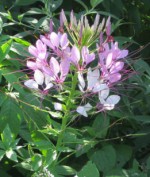 Also called pink queen and grandfather’s whiskers, this annual is a native of South America and a member of the Cleomaceae, a family closely related to the mustard family. The flowers appear all season long in terminal racemes 6-8″ wide. Each flower has 4 clawed white, pink, rose or purple petals and six 3″ long thin stamens that protrude from the flowers and look like the legs of spiders, giving the plant its common name. These stamens together with the abundant long slender pods that follow as the flowers fade add to the light fluffy look of the plants as they grow to 3-6’ tall from a stout taproot. The palmately divided leaves are attractive but have spines at their base and produce a slightly sticky and odiferous substance that some people find objectionable. Tall varieties are a good choice for the back of the border, where they will attract butterflies and birds, against a fence, in large containers, and in shrub borders, filling in until the shrubs reach their mature size. Spider flower is easy to start from seed and reseeds itself with abandon. Great old fashioned plant and good choice for a cottage garden. The genus name, Cleome, is the ancient name for a plant in the mustard family. The specific epithet, hassleriana, honors Emile Hassler, 20th century Swiss plant collector.
Also called pink queen and grandfather’s whiskers, this annual is a native of South America and a member of the Cleomaceae, a family closely related to the mustard family. The flowers appear all season long in terminal racemes 6-8″ wide. Each flower has 4 clawed white, pink, rose or purple petals and six 3″ long thin stamens that protrude from the flowers and look like the legs of spiders, giving the plant its common name. These stamens together with the abundant long slender pods that follow as the flowers fade add to the light fluffy look of the plants as they grow to 3-6’ tall from a stout taproot. The palmately divided leaves are attractive but have spines at their base and produce a slightly sticky and odiferous substance that some people find objectionable. Tall varieties are a good choice for the back of the border, where they will attract butterflies and birds, against a fence, in large containers, and in shrub borders, filling in until the shrubs reach their mature size. Spider flower is easy to start from seed and reseeds itself with abandon. Great old fashioned plant and good choice for a cottage garden. The genus name, Cleome, is the ancient name for a plant in the mustard family. The specific epithet, hassleriana, honors Emile Hassler, 20th century Swiss plant collector.
Type: Annual (perennial in zones 8-10).
Bloom: Large racemes of white, pink, rose, or mixed colored flowers, are borne through out the summer until frost.
Size: 3-6’ H x 1-3’ W.
Light: Full sun to part sun.
Soil: Average, light, moist, well drained, but tolerates some dryness when established.
Care: Deadheading to encourage flowering; may be shaped by pinching terminal growth when about 1’ high to promote the development of branches.
Pests and Diseases: None of significance but susceptible to aphids, spider mites, whiteflies, Japanese beetles, mildew and rust.
Propagation: Seed but hybrids may not come true. Reseeding can become a problem but seedlings are easy to remove and are stopped by a covering of mulch.
Companion plants: Plant shorter annuals or perennials such as celosia, gomphrena, or gooseneck lysamachia, in front of spiderplant to hide its leggy lower stems.
Outstanding Selections: ‘White Queen’; ‘Violet Queen’.
